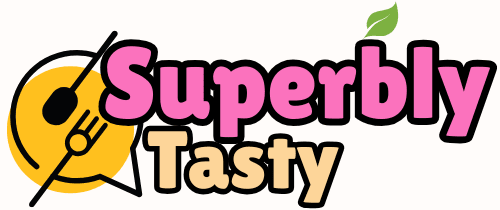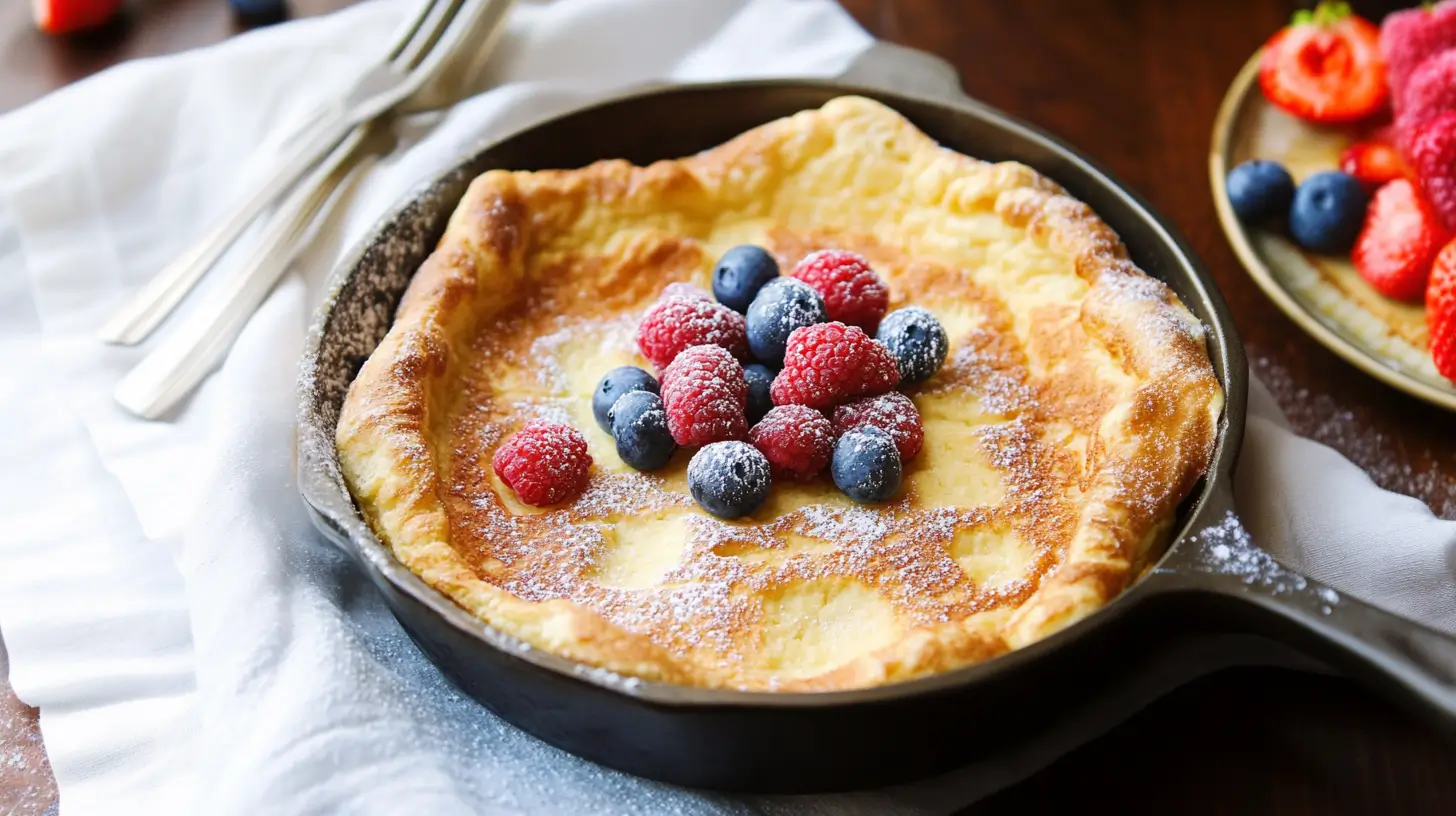You’ve probably had your fair share of pancakes and waffles, but have you ever tried a Dutch Baby? This fluffy, golden breakfast treat is a showstopper. Now, imagine enjoying that same mouthwatering experience without any of the gluten—sounds too good to be true, right? Well, with a gluten-free Dutch Baby, you can have the best of both worlds.
Whether you’ve been living the gluten-free lifestyle for years or you’ve just recently embraced it, this recipe is perfect for you. It’s light, airy, and full of flavor, with the perfect combination of crispy edges and a tender center. And the best part? You don’t have to sacrifice taste for dietary needs.
In this article, we’ll walk you through everything you need to know about making a gluten-free Dutch Baby, from the ingredients and cooking methods to variations, tips, and tricks that guarantee success. So, let’s dive in and bring this beloved breakfast dish to your table, completely gluten-free.
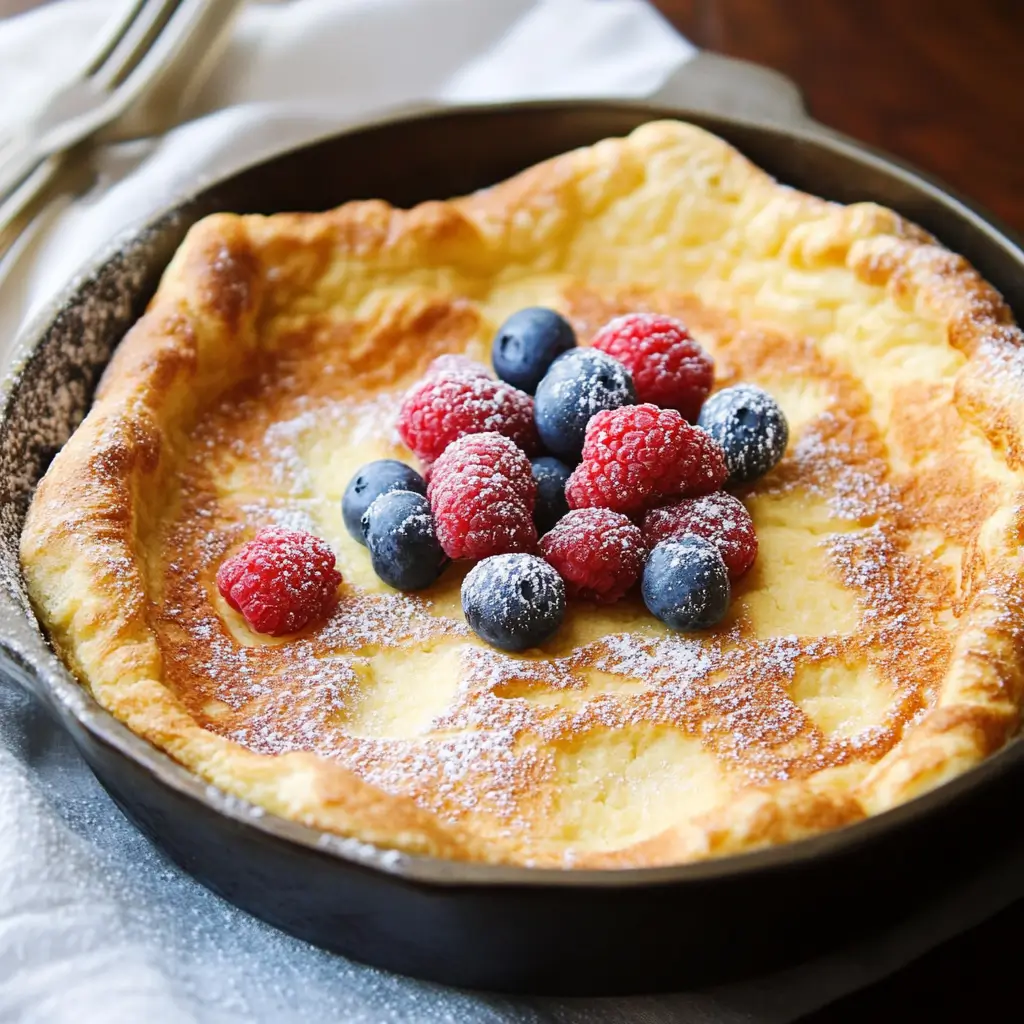
Table of Contents
What Is a Gluten-Free Dutch Baby?
Definition and Background
The Dutch Baby, often referred to as a “German pancake,” is a large, oven-baked pancake that puffs up as it cooks, creating a light, airy texture with crispy edges. Traditionally, it’s made from a simple batter consisting of eggs, milk, flour, and butter. It’s often served with a dusting of powdered sugar, a drizzle of syrup, or fresh fruit toppings.
For those who follow a gluten-free diet, however, making a traditional Dutch Baby presents a challenge. Gluten, found in wheat, rye, and barley, provides the structure and elasticity needed for the batter to rise properly. Luckily, by using a gluten-free flour blend, you can enjoy this delicious dish without the gluten.
Why Choose a Gluten-Free Version?
You might be wondering why a gluten-free version of this dish is necessary. Well, gluten-free eating is no longer just a trend—it’s become a lifestyle for many people with specific health needs, such as those with celiac disease or gluten intolerance. Others choose gluten-free foods to help manage digestive issues, inflammation, or to promote overall wellness.
No matter the reason, the good news is that a gluten-free Dutch Baby is just as delicious as its traditional counterpart. The best part? It allows you to indulge in a dish that’s usually off-limits when you’re avoiding gluten, while still satisfying your cravings for something sweet and fluffy.
Key Ingredients for Gluten-Free Dutch Baby
Before you get started, it’s important to know which ingredients are essential for making your gluten-free Dutch Baby. While many of the ingredients remain the same as a traditional Dutch Baby, there are a few key swaps that make this recipe safe for those who need to avoid gluten.
The Essential Ingredients You Need
| Ingredient | Amount | Purpose |
|---|---|---|
| Gluten-Free Flour Blend | 1 cup | Provides the structure for the pancake |
| Eggs | 4 large | Helps to bind and add structure |
| Milk (Dairy or Non-Dairy) | 1 cup | Adds moisture to the batter |
| Butter or Oil | 3 tablespoons | Adds richness and ensures no sticking |
| Vanilla Extract | 1 teaspoon | Adds flavor |
| Salt | 1/4 teaspoon | Balances flavor |
| Optional Toppings | As desired | Fresh fruit, powdered sugar, syrup |
- Gluten-Free Flour Options: The star of any gluten-free Dutch Baby is the flour. You can’t just use any flour in the recipe—you need one that will give the pancake the right texture. A gluten-free all-purpose flour blend works best for this dish, but if you want to experiment, you can also use almond flour, oat flour, or rice flour. Make sure your flour blend contains xanthan gum, which helps replicate the structure that gluten provides in a traditional recipe.
- Eggs: Eggs are crucial for binding the batter and giving the pancake structure. They help create the fluffy texture that makes a Dutch Baby so irresistible.
- Milk: Use whole milk or a dairy-free alternative like almond or coconut milk. If you’re sensitive to dairy, feel free to choose whichever milk suits your diet.
- Butter: Butter adds richness and flavor to the batter. It also helps to create a crispy edge, which is one of the best parts of the Dutch Baby.
- Vanilla Extract: A dash of vanilla enhances the flavor, giving the Dutch Baby a sweet, comforting aroma.
- Salt: A pinch of salt is necessary to balance out the sweetness and bring all the flavors together.
Optional Toppings and Variations
Once your gluten-free Dutch Baby is cooked to perfection, you can top it with your favorite additions. Here are a few popular options:
- Fresh Fruit: Berries, bananas, or sliced apples make excellent additions. You can even cook the fruit into the batter for a delicious fruit-filled Dutch Baby.
- Powdered Sugar: A light dusting of powdered sugar adds a sweet touch that completes the dish.
- Maple Syrup: This classic topping never disappoints. Pour it generously over your Dutch Baby for that sweet and savory balance.
- Whipped Cream: For an indulgent treat, add a dollop of whipped cream.
- Nut Butter: Almond butter or peanut butter provides a nutty contrast and a boost of protein.
Substituting Ingredients for Special Diets
If you have specific dietary needs, it’s easy to make adjustments. You can use dairy-free butter and non-dairy milk for a vegan version. Alternatively, opt for almond flour or coconut flour to make the dish lower in carbs. Experimenting with different gluten-free flours can give you a variety of textures and flavors, so feel free to get creative!
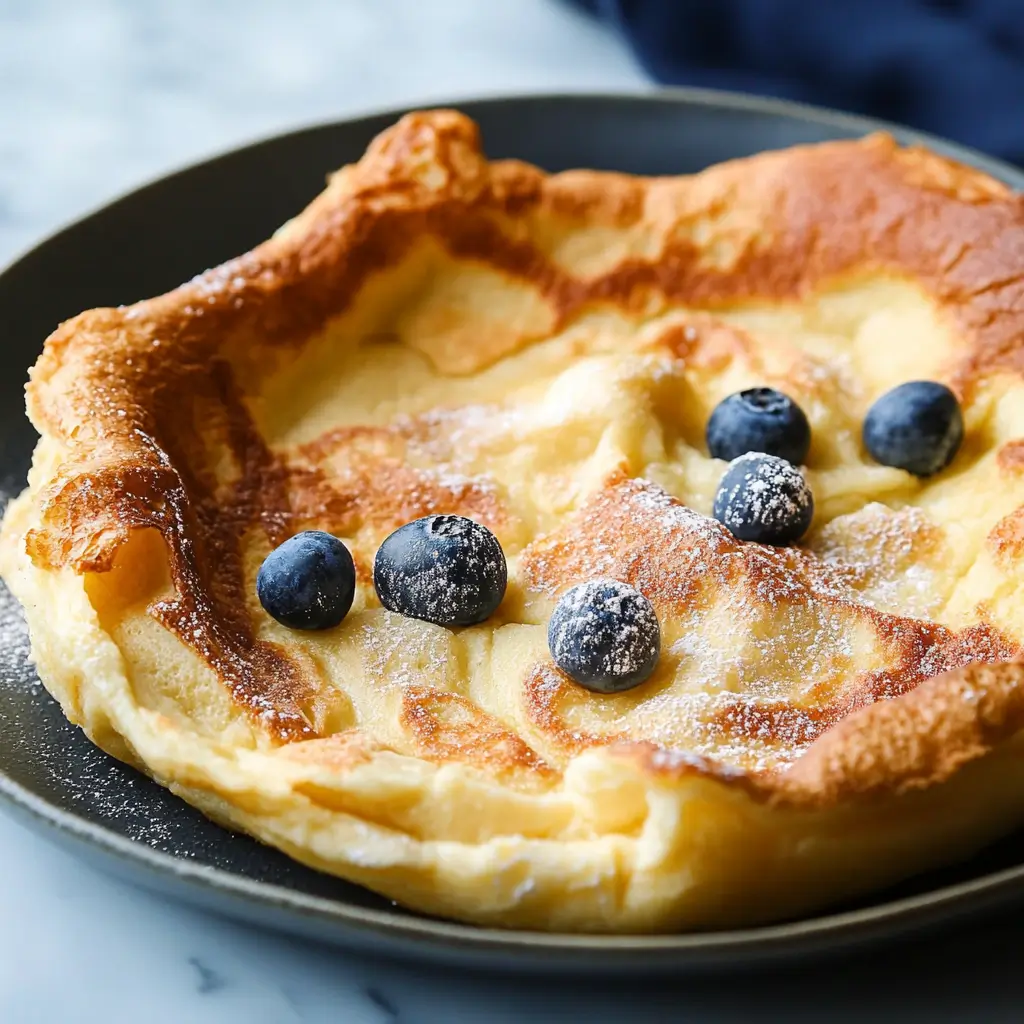
How to Make a Perfect Gluten-Free Dutch Baby
Now that you have the ingredients, let’s go over the step-by-step process of making the perfect gluten-free Dutch Baby.
Step-by-Step Instructions
Step 1 – Prepare Your Ingredients
Start by preheating your oven to 425°F (220°C). Place your cast-iron skillet in the oven to heat as well. The key to achieving that crisp edge is using a hot skillet, so this step is essential.
In a mixing bowl, whisk together the gluten-free flour, salt, and any dry ingredients. In a separate bowl, whisk together the eggs, milk, melted butter, and vanilla extract.
Step 2 – Mix the Batter
Slowly add the wet ingredients into the dry ingredients, stirring until smooth. Make sure there are no lumps in your batter. If you’re using a gluten-free flour blend, it’s crucial to ensure everything is well combined. Gluten-free flour can sometimes be clumpy, so give it a good stir.
Step 3 – Cooking the Dutch Baby
Carefully remove the hot skillet from the oven (use oven mitts!) and melt a tablespoon of butter in it. Swirl the butter around to coat the bottom and sides of the skillet. Then, pour the batter into the skillet, making sure it’s evenly spread.
Return the skillet to the oven and bake for 20-25 minutes, or until the edges are golden brown and the center is puffed up. Don’t open the oven door during the baking process, as this can cause the pancake to deflate.
Step 4 – Finishing Touches
Once the Dutch Baby is done, remove it from the oven. Serve immediately with your favorite toppings. The Dutch Baby will naturally deflate as it cools, so it’s best to enjoy it right away.
Common Mistakes to Avoid
- Using the wrong gluten-free flour: Not all gluten-free flours are the same. Some don’t behave the same way as wheat flour, which can lead to a dense or gummy texture. Stick with a good all-purpose gluten-free flour blend that contains xanthan gum.
- Not preheating the skillet: A hot skillet is essential for creating the crispy edges. If you don’t preheat it, your Dutch Baby may not cook evenly.
- Overmixing the batter: Overmixing can cause the batter to become too thick, leading to a dense texture. Stir gently until everything is just combined.
Gluten-Free Dutch Baby Variations
Once you’ve mastered the basic gluten-free Dutch Baby, you can experiment with different flavors and toppings. Here are a few variations to try.
Sweet Gluten-Free Dutch Baby
If you have a sweet tooth, consider adding cinnamon or nutmeg to the batter for extra flavor. Top your Dutch Baby with fresh berries, a drizzle of honey, or a dollop of whipped cream.
Savory Gluten-Free Dutch Baby
For a savory twist, add cheese, herbs, or even vegetables like spinach, mushrooms, or bell peppers to the batter. This version is perfect for a brunch or light lunch.
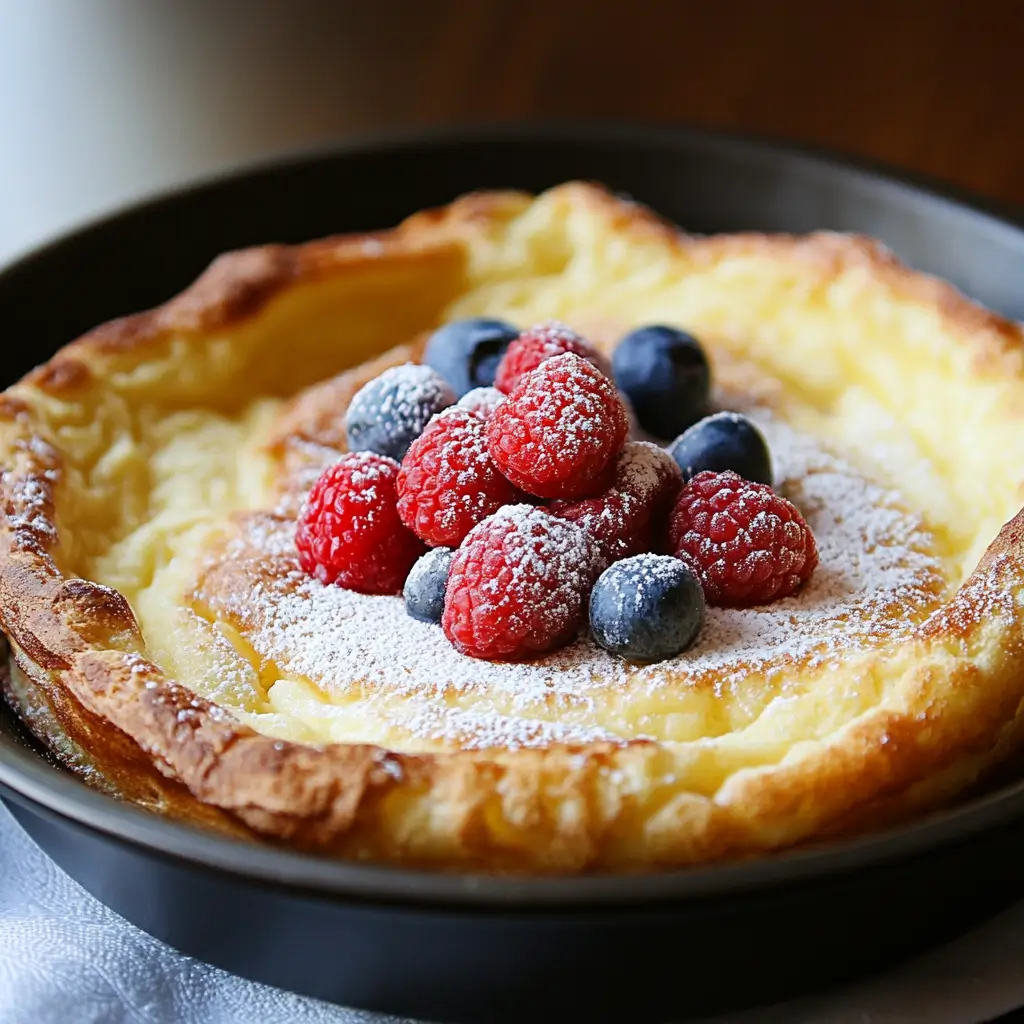
Nutritional Benefits of a Gluten-Free Dutch Baby
While a Dutch Baby is typically considered a treat, there are some health benefits to making it gluten-free.
Gluten-Free and Health-Conscious Options
If you’re using a gluten-free flour blend made with rice flour or almond flour, your Dutch Baby can be lower in carbohydrates and higher in protein. Almond flour, for example, is a great source of healthy fats and protein, which can help keep you fuller for longer.
Calories and Macronutrient Breakdown
Here’s a quick breakdown of the typical calories and macronutrients in a gluten-free Dutch Baby. These values are approximate and can vary based on the ingredients you use.
| Ingredient | Amount | Calories | Protein | Carbs | Fat |
|---|---|---|---|---|---|
| Gluten-Free Flour | 1 cup | 120 | 2g | 24g | 1g |
| Eggs | 2 | 140 | 12g | 2g | 10g |
| Butter | 2 tbsp | 200 | 0g | 0g | 22g |
| Whole Milk | 1/2 cup | 75 | 4g | 8g | 4g |
Tips for a Successful Gluten-Free Dutch Baby
Achieving the Right Texture
For a perfect gluten-free Dutch Baby, it’s crucial to get the texture just right. The batter should be smooth, and the skillet should be preheated so the pancake can puff up evenly. Make sure you’re using the right gluten-free flour blend to ensure the proper consistency.
Storage and Leftover Tips
If you have leftovers, store them in an airtight container in the fridge for up to 3 days. To reheat, place it in a 350°F oven for about 10 minutes to restore the crispy edges. You can also repurpose the leftovers by turning them into a breakfast casserole or using them as a base for other dishes.
Frequently Asked Questions (FAQ)
Can I make this Dutch Baby dairy-free?
Yes! You can substitute the butter and milk with dairy-free options like coconut oil and almond milk. Make sure to also check the flour blend to ensure it’s suitable for your dietary needs.
How do I know if the gluten-free flour I’m using is the right one?
Look for a gluten-free all-purpose flour blend that includes xanthan gum. If it doesn’t, you may need to add 1/2 tsp of xanthan gum per cup of flour to help the batter rise and achieve the proper texture.
Can I freeze a gluten-free Dutch Baby?
Yes, you can freeze a gluten-free Dutch Baby. Allow it to cool completely, then wrap it tightly in plastic wrap and store it in the freezer for up to two months. To reheat, bake it at 350°F for 15 minutes.
What can I add to the batter to make it fluffier?
If you want your Dutch Baby to be even fluffier, add a teaspoon of baking powder or baking soda to the dry ingredients. This will help the batter rise and create a lighter texture.
Conclusion
A gluten-free Dutch Baby is an easy and delicious way to enjoy a classic breakfast dish while meeting your dietary needs. With the right ingredients and a few simple steps, you can create a light, fluffy pancake that’s just as satisfying as the original. Experiment with different variations, toppings, and flavors to make it your own.
Now that you know how to make the perfect gluten-free Dutch Baby, it’s time to get cooking! Don’t forget to share this recipe with friends and family who are also looking for tasty gluten-free breakfast options. Happy cooking!
Try These Extra Recipes
Gluten-Free Buttermilk Biscuits
Gluten Free Biscuit Recipe
High Protein Egg Bites
